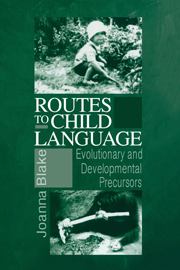Book contents
- Frontmatter
- Contents
- Preface
- 1 Prelinguistic Vocalizations
- 2 Sound–Meaning Correspondences
- 3 Communicative Gestures
- 4 Symbolic Gestures and Symbolic Play
- 5 Tool Use and Object Concept
- 6 Representation in Human Infants
- 7 Memory in Nonhuman Primates and Young Children
- 8 Origins of Language
- 9 Recapitulation
- References
- Index
5 - Tool Use and Object Concept
Published online by Cambridge University Press: 12 January 2010
- Frontmatter
- Contents
- Preface
- 1 Prelinguistic Vocalizations
- 2 Sound–Meaning Correspondences
- 3 Communicative Gestures
- 4 Symbolic Gestures and Symbolic Play
- 5 Tool Use and Object Concept
- 6 Representation in Human Infants
- 7 Memory in Nonhuman Primates and Young Children
- 8 Origins of Language
- 9 Recapitulation
- References
- Index
Summary
Tool use has been associated with language development both in evolution and in infancy. In evolution, the necessity to communicate with others regarding the use and construction of tools is considered to be among the most important forces propelling selection for verbal communication. The historical importance of tool use specifically in the extractive foraging of encased foods, such as nuts and tubers in the ground, and in food sharing, particularly of meat, has been emphasized. “The shift to primary dependence on extractive foraging with tools, and the attendant food sharing that characterized homind differentiation, favoured canalization of language-learning abilities and resulted in a strong propensity to acquire protolanguage” (Parker & Gibson, 1979, p. 374). Furthermore, language and manual dexterity are thought to be controlled by the same neural structures in the left hemisphere, namely, Broca's area and connected neural circuits (See Figure 1–2) (Greenfield, 1991).
Tool use in human infants is seen as underlying children's understanding of their ability to control the environment, including the international use of language to influence people (Siegel, 1981). An important prelinguistic milestone is achieved when infants extend their understanding of object tool use to the use of human agents as instruments (Bates, 1979). This instrumental use of persons has also been found in apes (Köhler, 1927; Gomez, 1990) and is sometimes called social tool use (Bard, 1990). Social tool use, or the understanding of adult agency, is addressed in chapter 3, so I do not discuss it further in this chapter.
- Type
- Chapter
- Information
- Routes to Child LanguageEvolutionary and Developmental Precursors, pp. 140 - 170Publisher: Cambridge University PressPrint publication year: 2000



